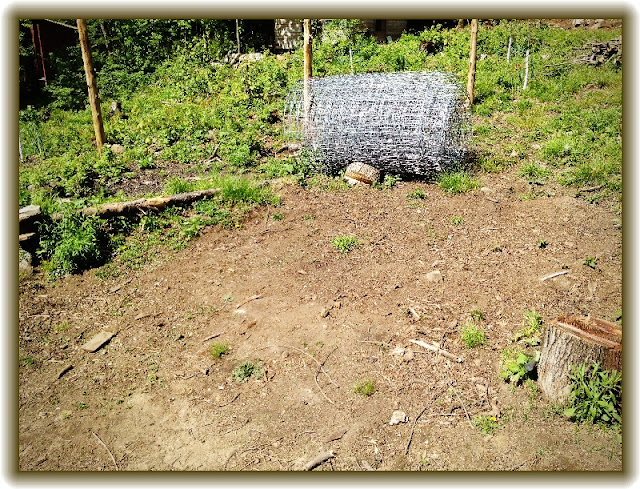Sunday, 20 May 2012
Raising Beds
This isn't the kind of land where you choose a garden location and then plant the spade and dig.
I won't mislead you; there are some places like that around here, but they are few and far between.
The crops out back will be planted into the existing earth.
The gardens, however, will all be raised beds.
Raised beds have great advantages over in-ground gardens.
Designed properly, they are easier to work and reduce soil compaction.
They are less vulnerable to burrowing pests.
They are usually well drained, and warm quickly in Spring.
And most importantly, they can be located wherever you like, regardless of the local soil conditions.
Our land is blessed with variety.
There are many soil types, sun and shade, north and south facing hills, and water sources.
Unfortunately, they don't all come together to form a perfect garden location.
That part is our responsibility.
At the base of our fruit hill, there is....nothing.
It's dry and devoid of good soil.
The moisture that flows through the hill, flows laterally, and not downwards.
But it does face south, and it is close to the house and water hose.
Having moved the trail close to the new fence line, a new opportunity presented itself.
A space that begged to be filled.
Kira needs a sunny place for tomatoes and peppers.
There had been plans for the top of the hill, but this looked better.
Two stumps provided natural bracing for a couple of logs.
The resulting space was then filled in with rotten logs and dried brush from old piles close by.
I believe this is called Hugelkultur, but don't quote me on that. I haven't done the research.
The idea is that the woody organic material provides good drainage, while at the same time, retains moisture.
The decaying logs slowly release nutrients from below and harbour organisms that promote soil production.
The soil is placed on top of the brush and logs.
What a great place to hide brush and old logs.
In last year's pig yard, there is a fertile corner that is really a little swamp.
The ground is soaked, but the earth is divine.
There is little sun in this spot, and it's really too wet for gardening.
By relocating the soil, a ditch is created that helps dry out the road leading to the woodlot.
Once it's totally cleared out, it should end up being a frog pond.
This job could have been done with a wheelbarrow and shovel, but not today.
I borrowed my Dad's tractor for the job.
The shovel gets it's fair share of work and then some.
With the exception of a small pile for other projects, the horse manure that we scored last Winter went into the bed on top of the brush, and then the swamp dirt on top.
Once it has dried out somewhat, we'll stir it up and break the clods of dirt.
There is a lot of root system in the mix which should provide a steady source of fresh nutrient over time.
In addition to the wood underneath, and run-off from the hill, this garden should need very little amendment.
There is still a lot of soil to be harvested from this yard.
Some of it went to another location to serve as part of a squash heap.
Mixed with aged horse manure, the swamp dirt will be used for a raised bed for squash.
This is better done as a hill instead of a contained garden.
Just heap the rich soil and plant squash in it.
I always say that you must let the land tell you where and what to plant.
Sometimes, that involves being creative with the materials on hand.
If there was no good soil for me to move, I would be far more aggressive when it comes to hunting down free animal manure. I bet that most stables would be happy to see the waste leave.
Once the bed is established, maintaining the fertility is a matter of applying whatever organic material you can, such as compost and animal waste.
Each and every raised bed that we build gives us more freedom to properly rotate plantings in the future.
This raised bed will take some work yet, before the soil is broken up and equalized.
But now that it has been built, it will always be here for us.
Subscribe to:
Post Comments (Atom)








No comments:
Post a Comment